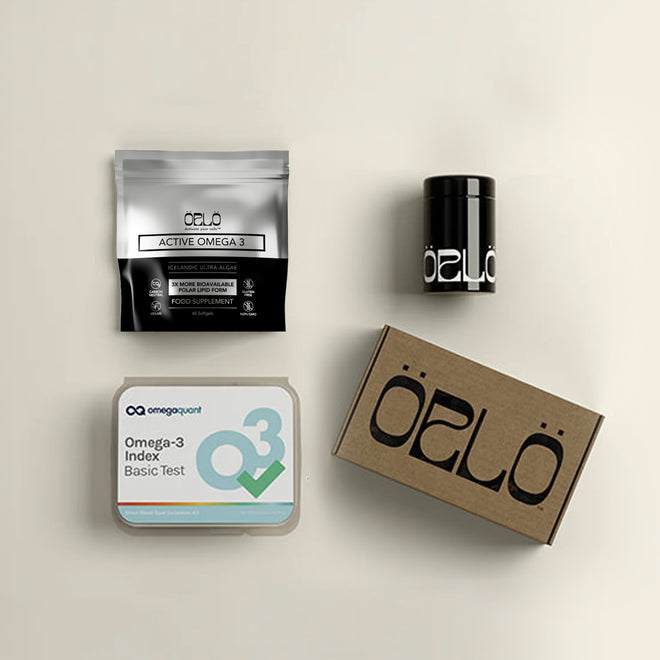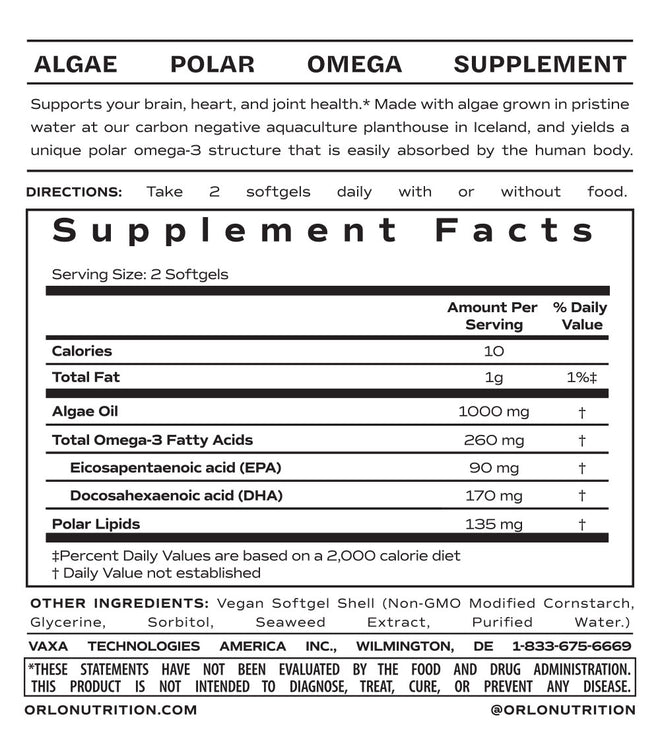25% Off - use code: HOLIDAYS
5 Reasons to Choose Algae Over Fish oil for Your Omega-3s
Shift your omega-3 consumption from fish oil to algae oil and make a change that will support your health and also restore planetary health.
There’s no denying that fish oil has become a very popular way to get your daily omega-3s, but questions arise around the sustainability of the fish used to produce fish oil supplements. Can we rely on the source? Is it sustainable? Is it pure? In each of the 5 sections below, you’ll learn about some of the problems of relying on fish for our omega-3s and how algae can come to our rescue.
#1: Fish get their omega-3s (EPA and DHA) from the algae they eat.
Did you know that fish, like us, get their omega-3s, eicosapentaenoic acid (EPA) and docosahexaenoic acid (DHA), from the algae they eat? Fish bioaccumulate these important omegas, along with a dose of toxins like heavy metals, dioxins, furans and flame retardants.
By cutting out the middle fish and going straight to the microalgae that produce EPA and DHA, you’re getting the omegas without additional environmental pollutants.
#2: We have a plastic pollution problem.
All of the oceans of the world are connected. Visible examples of polluted waterways, including The Great Pacific Garbage Patch, continue to grow. Each of us now consumes more than a credit card worth of plastic each week, and foods from our oceans are direct contributors to that reality. Fish themselves eat microplastics that they mistake for plankton and algae, and bigger fish bio-accumulate these plastics along with heavy metals, dioxins, furans and other pollutants including flame retardants.
Thankfully microalgae species provide a safe and easy solution. Algae does not bioaccumulate toxins and pollutants. It can be grown indoors in safe and pure conditions. This means it can be minimally processed while providing maximum nutrition impact – and you can consume your omegas from algae without contributing to the plastic pollution problem – and without an extra dose of plastic.
#3 Our oceans are warming.
As our atmospheric carbon levels climb, our oceans also absorb more and more carbon. As a direct result, they are becoming more acidic. With rising acidity, our oceans have one more contributor to their warming. Coral reefs have considerable trouble recovering from their decimation and species of mollusks are even having a hard time making the shells they need to survive. In short, beyond the question of whether our present fishing practices are sustainable in any of our oceans, the state of our ocean ecosystems are in peril. Our oceans are ultimately becoming less friendly to the very life they support. This means that fish with thriving populations today could fall quickly into collapse with the changing conditions of our oceans and waterways.
Here again, microalgae supply a simple solution. Algae grown through photosynthesis consumes carbon and creates oxygen as a byproduct. This means that algae is capable of drawing down atmospheric carbon, sequestering that carbon, and producing omega-3, protein, and other phytonutrients with minimal inputs. Algae itself plays a part in solving our climate concerns, reversing global warming while nourishing our bodies.

#4: There is enough omega-3 for everyone, if we shift to algae!
If every person were to start consuming omega-3s from fish today, there would not be enough fish in the sea to support that effort sustainably. This is known within the omega-3 industry, and it fuels the decision by some producers to shift resources to farmed fishing practices. But with increases in fish farming, the demand for feeder fish — pelagic fish like sardines and anchovies — continues to rise. These feeder fish are the fish we rely on to extract most of the omega-3 fish oils on the market today. Do you see the circular problems we have created?
At VAXA Technologies, a food tech company and the owner of the Örlö Nutrition brand, microalgae are grown in Iceland using a patented, closed and controlled environment. They use only energy and 99% less land and water than other methods. Since algae grows exponentially, doubling itself each 2 days when conditions are optimized, they can produce omega nutrition without ever impacting marine ecosystems. The exponential growth cycle of microalgae means continual harvest is the norm, creating a positive cycle of endless abundance. Water used to grow algae can be used again and again.
#5 Algae can be grown without disturbing sensitive ecosystems.
Our ocean ecosystems are at a tipping point. If we continue to harvest them at the same pace we are today, and if we aren’t mindful of letting significant portions of our oceans “go wild” and rest, we may be hastening complete ecosystem collapse. Current recommendations from environmentalists, including the New York Times bestselling author, Paul Hawken, who authored Regeneration: Ending the Climate Crisis in One Generation, are to set aside 30% or more of our wild land, waterways, and oceans, so these spaces can recover. They caution us not to choose dead-zones, or undesirable locations, but rather thriving ecosystems that aren’t near collapse. This will be very hard to do if we don’t change our consumption habits globally.

Pictured above: VAXA Technologies' photo-bioreactor at their aquaculture planthouse in Iceland.
We know that we can grow algae in controlled conditions that do not negatively impact ocean ecosystems. Örlö Nutrition products are produced using 99% less water and land resources than other nutrient resources. We’ve already proven that these algae oils are safe, clean options for long-term use.
Take the first steps and incorporate Örlö Nutrition’s Ömega-3 or Prenatal DHA into your daily routine! Receive $10 off your starter kit and get 15% off when you subscribe today.
But can omega-3s from algae truly replace our reliance on fish oil?
Over the last decade, DHA sourced from microalgae has moved into mainstream acceptance. It has been added to everything from DHA fortified cow’s milk. to baby formula, to vegan omega-3 supplements. It’s apparent therefore that we can supplant our consumption of DHA easily with algae oils that are available.
But what about the EPA?
But what about the EPA that has been defined as also critical to our body’s optimal health? Until recently, algae-sourced EPA was difficult to find. That tide is shifting, as producers have perfected growing different strains of algae that also produce EPA.
Vaxa Technologies, Ltd., owner of Örlö Nutrition is one such provider who achieves healthy levels of the daily omega-3 you need with both EPA and DHA at efficacious levels and in their highly bioavailable polar lipid form. This means their/our products deliver 2–3 times the absorption of fish or krill oil.
With Örlö Nutrition, you get an algae oil that checks all the boxes.
Not all algae production system are the same. Only algae that is grown in a controlled, closed system, provides a sustainable solution that isn’t subject to the same problem of plastic or environmental pollution, not to mention the ever-changing conditions traditional algae agriculture system bring. Since the algae Örlö grows in our controlled indoor aquaculture planthouse in Iceland, uses pristine water and energy, the final product is verifiably clean, pure, consistent and sustainable. Because the system is closed, no pests can get into the algae. No undesired algae strains can take over. No pesticides are needed. No atmospheric pollutants like dioxins, PCBs, heavy metals and furans can get in. It’s clean. It’s safe. It’s pure. And because it starts out that way, processing of the oil is minimized, preserving the omega-3s in their polar lipid form. This makes Örlö’s particular algae source more bioavailable and bio-active. The EPA and DHA readily enter your body’s tissues where they can do the most good.
It’s time for a new era of nutrition, one that relies less on our oceans and ecosystems and more on the world’s first plants — microalgae.
If we can give up our fish oil for algae oil, we’ll be taking one more step in the right direction — paving the way for algae to sequester more carbon, produce more oxygen, and even cool our home planet.















